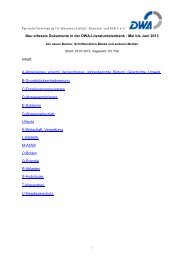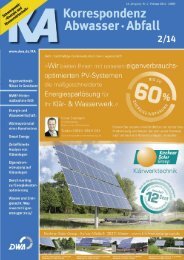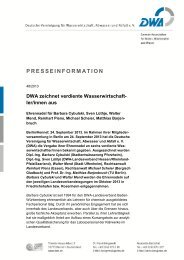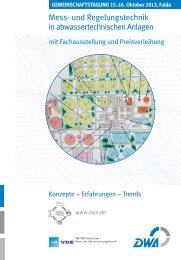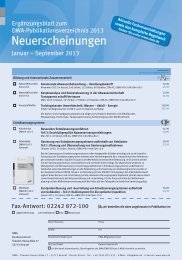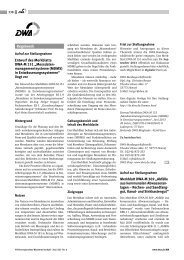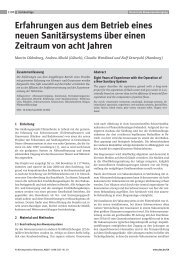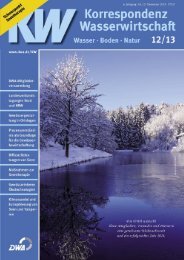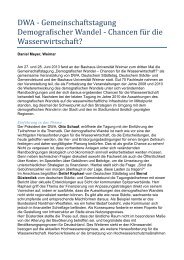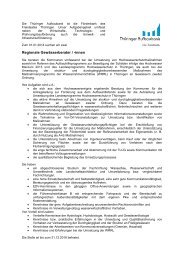Forschungsprojekte Anthropogene Spurenstoffe - DWA
Forschungsprojekte Anthropogene Spurenstoffe - DWA
Forschungsprojekte Anthropogene Spurenstoffe - DWA
Sie wollen auch ein ePaper? Erhöhen Sie die Reichweite Ihrer Titel.
YUMPU macht aus Druck-PDFs automatisch weboptimierte ePaper, die Google liebt.
<strong>Forschungsprojekte</strong> zu anthropogenen <strong>Spurenstoffe</strong>n im Wasserkreislauf<br />
42 Titel<br />
Kurztitel<br />
Verbundpartner/<br />
Projektnehmer<br />
Kontakt<br />
Projektträger/<br />
Finanzierung<br />
Anwendungsbestimmungen zum Schutz vor schädlichen<br />
Umweltwirkungen durch den Einsatz von Pflanzenschutzmitteln und ihre<br />
Beachtung in der Praxis<br />
Gesellschaft für Boden- und Gewässerschutz e.V.<br />
Martin Bach, Peter Fischer und Hans-Georg Frede Gesellschaft für<br />
Boden- und Gewässerschutz e.V. Hainerweg 33, 35435 Wettenberg<br />
UBA<br />
Veröffentlichung 4/ 1999<br />
Kurzfassung<br />
The goal of the project ist to compile all of the current environmentally-relevant usage<br />
regulations for all relevant fields of pesticide application (agricultural, non-agricultural areas,<br />
horticulture) to the environmental mediums: ground water, surface water and atmosphere.<br />
Furthermore, an overview as to how the usage regulations can be put into practice has been<br />
included, along with a short description of the pesticide occurence in the environment caused<br />
by each field of application. In a further step the current deficiencies in the legal provisions<br />
and in the management practices of crop protection will be presented and measures to<br />
improve the stated deficiencies discussed.<br />
The term „Usage Regulations“ includes the central provisions of the crop protection law,<br />
namely the Crop Protection Act (Pflanzenschutzgesetz, PflSchG), the Crop Protection Decree<br />
(Pflanzenschutzmittelverordnung, PflSchMV), the Crop Protection Competence Decree<br />
(Pflanzenschutz-Sachkundeverordnung, PflSachV), and the Crop Protection Application<br />
Decree (Pflanzenschutz-Anwendungsverordnung, PflSchAnwV), as well as, other subregulatory<br />
provisions. These regulations were recently compiled in the Code of Best<br />
Management Practice by the German Ministry of Food, Agriculture and Forestry (BMELF<br />
1998). Additionally for some fields of crop protection further acts are relevant, e.g. Chemical<br />
Products Act (Chemikaliengesetz, ChemG), the Water Act (Wasserhaushaltsgesetz, WHG) or<br />
the Decree for Dangerous Substances (Gefahrstoffverordnung, GefStoffV).<br />
The sprayer handling on the farmyard and the disposal of remaining spray solution and<br />
pesticide containers have been identified as the most dominant sources of pesticide emissions<br />
into the aquatic environment, whereas the groundwater is the most seriously affected part of<br />
the environment. Diffuse inputs in waters from runoff, tile drains and pesticide application on<br />
non-agricultural lands are also of environmental significance. However, the contribution of<br />
pesticides from the storage of sprayers and crop protection products, the input via spraydrift<br />
and pesticide application in private gardening are of little relevance.<br />
Serious regulatory deficiencies are recognized when considering the path of entry of<br />
„runoff/water erosion“ and the principles for pesticide application in private gardens. For all<br />
other actions and pathways of entry, the lack of regulatory and sub-regulatory provisions is<br />
less relevant or negligible.<br />
While attempting to implement these usage regulations, further considerable deficiencies<br />
were recognized. Primarily, the regulations of pesticide application NW 600 and NW 601<br />
54



